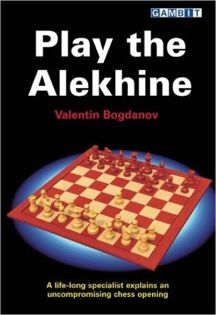Play The Alekhine
Valentin Bogdanov

PLAY THE ALEKHINE by Valentin Bogdanov is a reasonably priced introduction to one of Blacks more active defenses to 1.e4. The Alekhine was always considered a second rate defense until Bobby Fischer used it in games 13 and 19 of his 1972 World Championship against Boris Spassky, scoring a win and a draw. Recently its adoption by Carlsen, Ivanchuk and Mamedyarov has fueled new interest.
Bogdanovs third work for Gambit Publications (his earlier works were on the French and the Grunfeld) follows the standard format for this series with 26 deeply annotated games played in the past decade. The material breaks down as follows:
1 White Does Not Play 2 e5 7
2 The Chase Variation 28
3 The Four Pawns Attack 42
4 The Old Main Line: 4 Nf3 Bg4 62
5 The New Main Line and 4th Move Alternatives 82
6 Exchange Variation 103
7 2 e5 Nd5: 3 Nc3 and Other Moves 117
Index of Variations 126
PLAY THE ALEKHINE is a fine introduction to this opening with a few caveats. Bogdanov does a good job of explaining the ideas for both sides and explaining what lines are popular and why. Even stronger players will appreciate some of the trends he points out like 1.e4 Nf6 2.e5 Nd5 3.d4 d6 4.Nf3 dxe5 5.Nxe5 c6 used by Carlsen to defeat Topalov. Where this book has to cut corners is in its detailed examination of theoretical lines. For example one wouldnt consider 1.e4 Nf6 2.Nc3 to be particularly necessary of close study but if one stays true to an independent Alekhine spirit with 2…d5 after 3.e5 d4 4.exf6 dxc3 5.fxg7 cxd2+ 6.Bxd2 Bg7 a surprisingly sharp position arises after 7.Qf3, a favorite of the Swedish GM Jonny Hector and the subject of a very recent article in New in Chess magazine by Jeroen Bosch (issue 8 of 2009). Bogdanov covers this line briefly, and the magazine appeared while the book was being printed, but the point is clear this series is all players below 2000 will ever need, but for those at strong club level on up it should be used as an introduction and supplemented with specialist material (MegaDatabase 2010, TWIC, New in Chess Yearbooks, Chess Publishing.com, detailed opening books, etc.).
